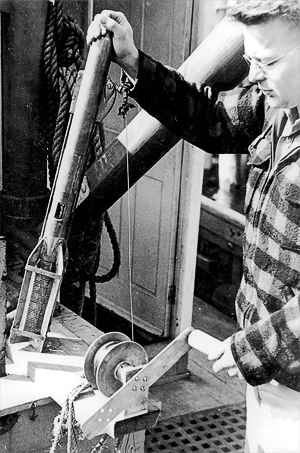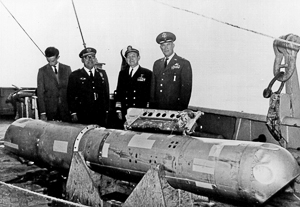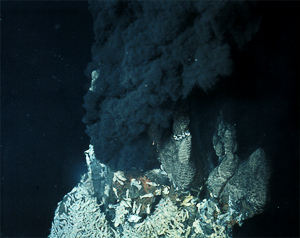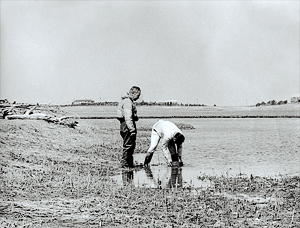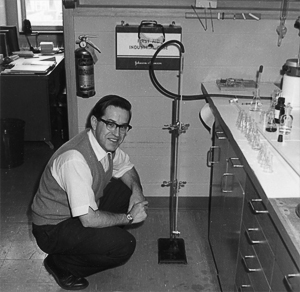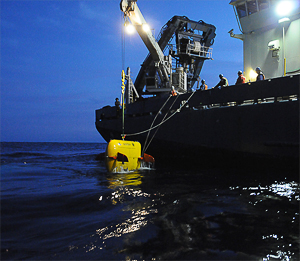“Basic research, directed simply toward more complete understanding of nature and its laws, embarks upon the unknown. Clearly, that which has never been known cannot be foretold, and herein lies the great promise of basic research. … [It] enlarges the realm of the possible. In the mid-1930s, a young physicist named Maurice Ewing sent letters to several oil companies. He asked them to “support a modest program of research” to see whether the seismic methods he was pioneering on land could be adapted to investigate the completely unknown geology of the seafloor. “This proposal received no support whatever,” Ewing later wrote. “I was told that work out in the ocean could not possibly be of interest to the shareholder and could not rightfully receive one nickel of the shareholder’s money.” Ewing did get a $2,000 grant from the Geological Society of America, however, and thus funded, he and his students came to Woods Hole Oceanographic Institution (WHOI) to use its new deep-sea research ship, Atlantis. They launched novel experiments using explosions to generate sound waves to probe the structure of the seafloor. To Ewing, the ocean was annoyingly in the way—that “murky mist that keeps me from seeing the bottom,” he called it. To study the seafloor, he and his colleagues had to learn how to negotiate the intervening medium. In the process, they unexpectedly made profound and fundamental discoveries about seawater properties and how sound propagates through the ocean. In 1940, on the eve of war, WHOI Director Columbus O’Donnell Iselin wrote a letter to government officials, setting forth “some suggestions as to how the personnel and equipment of this laboratory can be better utilized for the national defense.” Soon after, one of Ewing’s students, Allyn Vine, began incorporating their newly gained knowledge. He built instruments (bathythermographs) to measure ocean properties and trained sailors to use them to escape detection by sonar. It was the first among many applications of this basic research that revolutionized submarine warfare. Bringing science to bearMany scientists pursued the marine geophysics research initiated by Ewing (who moved to Columbia University after World War II). Their work culminated in the late 1960s in the unifying theory of plate tectonics. It transformed our understanding of continents, ocean basins, earthquakes, volcanoes, and a host of other geological phenomena—including significant oil reservoirs beneath the seafloor where oil companies now routinely drill and make money for their shareholders. Vine remained at WHOI and spearheaded deep-submergence technology, including the research submersible Alvin, which was named after him. Two years after it was completed, Alvin was applied to a national emergency, locating a hydrogen bomb that accidentally dropped into the Mediterranean Sea. A decade later, plying a basic research mission, Alvin found seafloor hydrothermal vents. To scientists’ utter astonishment, the vents were surrounded by previously unknown organisms sustained not by photosynthesis but chemosynthesis. The discovery completely rearranged our conceptions of where and how life can exist on this planet and elsewhere in the universe. In 1969, another event occurred that is central to this story. The barge Florida spilled 189,000 gallons of oil off West Falmouth, Mass., just up the road from WHOI. In the months following, WHOI biologists Howard Sanders and George Hampson collected marine life and shared them with Max Blumer and Jerry Sass, WHOI geochemists who pioneered the use of gas chromatography to detect low levels of organic compounds in seawater, sediments, and organisms. WHOI marsh ecologist John Teal and graduate student Kathy Burns adapted the techniques to study the fate and effects of oil over several years. “You had modern science brought to bear on this oil spill,” said WHOI scientist emeritus John Farrington in 2011. “You had a lot of expertise, and scientists who were willing to really extend studies outside the box and figure out what was going on.” Their studies refuted the prevailing wisdom that the oil was gone when it was no longer visible in the water and on beaches. They showed that oil persisted in marshes and sediments for years and continued to have impacts on ecosystems. “This didn’t sit very well with many of the public-relations specialists and some of the folks in charge of oil companies,” Farrington said. “So [the WHOI scientists] came under really vicious attack in the press and by political means, but they stood their ground and they spoke out. Not only did they publish peer-reviewed scientific publications, but they also wrote stories that could be understood by the lay public. They testified in Congress. They brought their story to international conventions and meetings.” Farrington came to WHOI as a postdoc with Blumer just after the spill and collaborated with Teal and others, heralding successive generations of scientists who made WHOI a leader in oil spill research. That tradition was still thriving on April 20, 2010, when the Deepwater Horizon oil rig exploded, killing 11 people and causing the largest accidental oil spill in history. A national resourceThe ruptured Macondo well pipe spewed oil at an unprecedented depth. It was aqua incognita to the oil industry, but a familiar neighborhood for WHOI scientists, who mustered their deep-submergence technology and expertise and combined it with their singular experience studying oil spills. “Everything we had developed to fulfill those other oceanographic missions could be applied to this new crucial problem,” said WHOI scientist James Kinsey. “We were ready when the time came.” “We viewed the institution as a national resource,” said Robert Munier, WHOI vice president for marine facilities and operations. “We had capabilities, tools, and expertise, and it was incumbent for us to make them available in a national emergency.” Responding to calls from several government agencies, more than 100 WHOI staff—chemists, biologists, physical oceanographers, engineers, and technicians—nimbly mobilized a spectrum of equipment and technology, much of which scientists never imagined would be used to study an oil spill. WHOI was “preadapted” to respond to the spill, said Hugh Powell, a science journalist. “ ‘Preadaptation’ is a term borrowed from evolutionary biology. It refers to natural selection turning an existing structure to a novel use when the right conditions develop. In an analogous manner, WHOI’s culture of scientific inquiry meant that knowledge applicable to the oil spill response already existed and needed only to be applied to a new use.” Powell listed WHOI’s history of attracting top scientists and skilled, “can-do” personnel and its strength in developing unique ocean knowledge and technology (in this case, its expertise in hydrothermal vents, deep submergence, and oil spills). And he cited WHOI’s commitment to basic research and its “culture of collaboration and freedom of inquiry.” As an independent research institution, WHOI occupied an essential niche during the Deepwater Horizon crisis. Amid a media frenzy, WHOI scientists provided information but not speculation, steadfastly waiting for their results to go through the peer-review process. While industry and government worked feverishly to contain the spill, WHOI scientists could look beyond the bottom line and the next quarter, unconstrained by short-term mandates. They conducted research that industry and government couldn’t or didn’t. Their primary vested interest was pursuing knowledge, with unapologetic curiosity. They have always been, and still are, in it for the long haul, knowing that understanding natural phenomena always has a payoff. John Farrington recalled Max Blumer’s words during the 1969 West Falmouth oil spill: “I’ve been funded for years by the taxpayers, and they probably didn’t have any idea what I was doing," Blumer said. “Now I have an opportunity to show them that what they invested in has real, tangible results that can be helpful.” With its work on Deepwater Horizon, WHOI demonstrated that once again. Originally published: October 7, 2011 Last updated: April 21, 2014 | ||||||||||||||||||||||||||||||
Copyright ©2007 Woods Hole Oceanographic Institution, All Rights Reserved, Privacy Policy. | ||||||||||||||||||||||||||||||

